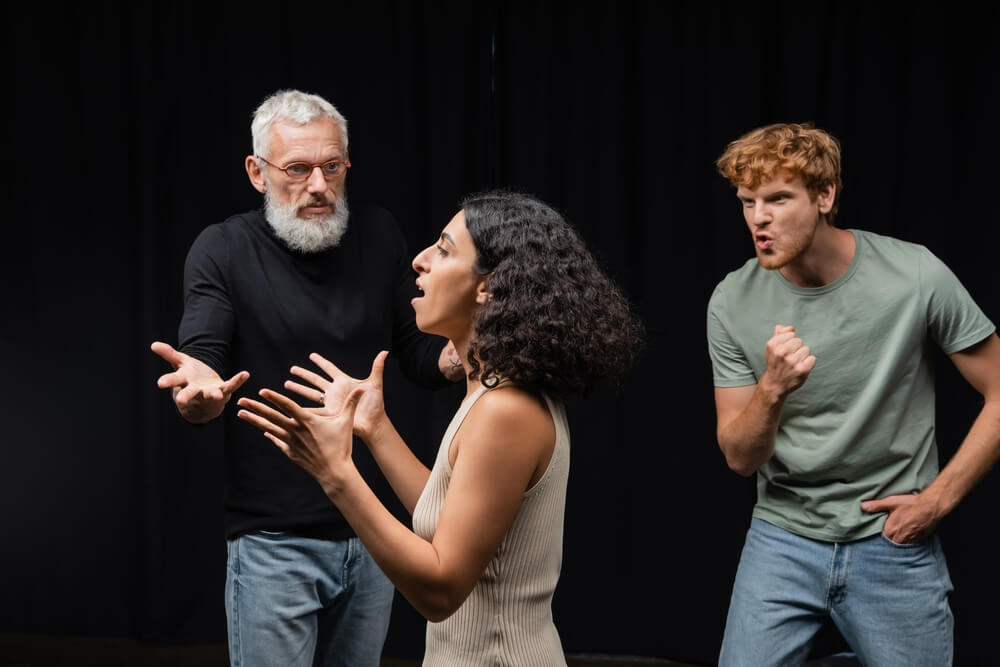Training the Next Generation: Acting Pedagogy and the Future of Performance
In a unique realm of our own, we immerse ourselves in the vibrant art of acting that dazzles audiences on stages and screens. The evolution of our craft has sparked changes in how it’s taught, shaping the field of acting pedagogy — the method and practice of teaching acting — over time. From ancient traditions to contemporary methods, the teaching of acting has adapted to societal, technological and artistic advancements. Let’s delve into the contrasting styles of traditional and modern acting education, trace the journey of acting pedagogy through history and ponder what lies ahead for aspiring performers.
Traditional Approaches to Acting Education
Historically, the foundation of acting education has been built upon techniques crafted by influential figures. Konstantin Stanislavski, a renowned name in acting philosophy, pioneered a method that prioritizes genuine emotions and deep psychological understanding. Referred to as the Stanislavski system, this approach urges actors to tap into their personal emotions and life experiences to imbue their performances with authenticity. (Check out Stanislavski’s book, Creating a Role, for an in-depth exploration of his techniques on character development and performance preparation.)
In the mid-20th century, this approach was further adapted by practitioners like Lee Strasberg, who developed the Method Acting technique. This technique asks actors to immerse themselves so deeply into their characters that they continue to embody them even off-stage or set—a practice that has produced some of the most intense and critically acclaimed performances in film and theater.
On the other hand, practitioners like Stella Adler and Sanford Meisner focused on external techniques. Adler’s method emphasizes the importance of imagination in addition to emotional recall, arguing that actors should cultivate their ability to imagine circumstances outside of their personal experiences. Meisner, meanwhile, developed a technique that enhances an actor’s ability to react instinctively to the surrounding environment and other actors, promoting spontaneity in performances. (Stay fresh by utilizing The Sanford Meisner Approach: An Actor’s Workbook.)
Modern Developments in Acting Education
The digital age has ushered in new methodologies for training actors. Today, acting coaches and educators utilize a blend of traditional techniques with modern technology. Online platforms, virtual reality (VR) and digital simulations are increasingly common in acting studios, offering students a myriad of ways to practice their craft.
Furthermore, the increasing global reach of the entertainment industry has resulted in a heightened focus on incorporating cross-cultural training approaches. Today, actors are required to demonstrate unprecedented versatility, being proficient in various genres and environments. As a result, there has been a blending of diverse acting methodologies from different corners of the globe, such as traditional Indian dance-drama, Japanese Kabuki theatre and classic British Shakespearean acting.
The Role of Academia in Acting Pedagogy
Acting education is not confined to studios and workshops. Many universities and colleges offer comprehensive degrees in theater and performance arts. These programs combine practical performance opportunities with academic coursework in history, theory and the technical aspects of theater production, such as lighting, set design and directing. This educational framework enhances students’ grasp of the art form, equipping them for a wide range of opportunities within the entertainment sector.
The Future of Acting Pedagogy
Looking forward, the future of acting pedagogy appears to be one of hybridization and innovation. Virtual reality, having been on the rise, could become a standard tool in acting education, providing even more immersive environments for actors to practice and hone their skills. Artificial intelligence (AI) could also play a role, possibly in the form of digital coaches that provide real-time feedback during rehearsals.
There’s also a growing recognition of the importance of mental health in acting training. Methods that emphasize psychological safety and the emotional well-being of actors are becoming more prominent. This shift is a response to the often intense emotional exploration required in traditional methods, which can sometimes lead to psychological strain.
As acting techniques and methods keep changing, one key idea stays the same: acting training is all about being genuine, flexible and understanding of others’ feelings. Whether using old-school techniques or the latest innovations, the main aim is to train actors to not just act well but also to deeply understand and express human emotions. As the lines between different acting schools blur, future actors are shaping up to be very adaptable and aware of global styles. So, for anyone passionate about acting, the future looks promising and exciting.
Casting directors use Casting Networks every day to discover people like you. Sign up or log in today to get one step closer to your next role.
You may also like:
- ‘The Girls on the Bus’ Star Scott Cohen Talks Bertolt Brecht Plays, Joining the Circus and Why He Decided to Start Coaching
- Acting Up: Andrew Scott Steals the Show in Netflix’s ‘Ripley’
- Acting Up: Andrew Scott Steals the Show in Netflix’s ‘Ripley’
Ilana Rapp is a media-savvy Generation Xer with instinctive wit, quick humor and a taste for deep human emotions. As a former (child) actress with Broadway, film and television credits, she is adept at, well, lots of things.




